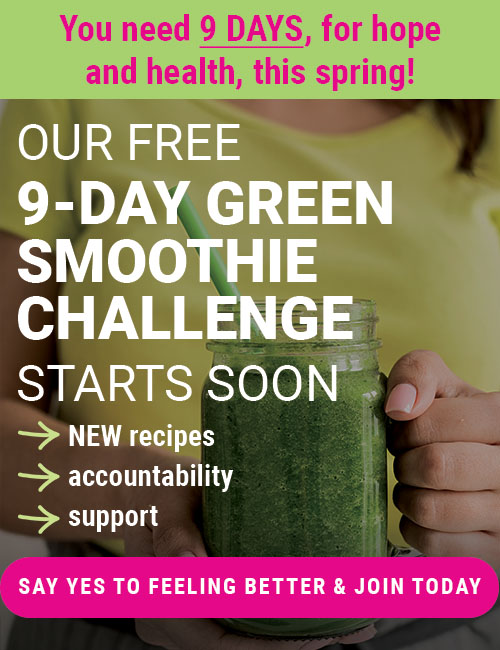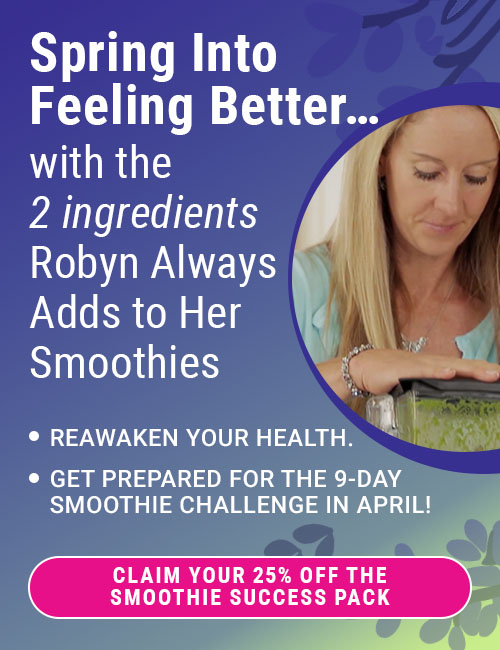Fermenting foods: it’s freaking me out!
Dear GreenSmoothieGirl: I really like the idea of adding the Rejuvelac as my green smoothie base, but I’m honestly totally freaked out to leave something perishable on my countertop in an unsealed container for several days. What are the chances that “bad bacteria” get in there and make me sick? I really appreciate any feedback you have. It sounds like a great opportunity to make green smoothies do even more for me, but I can’t get over the initial concept. –Grace
Answer: Grace, I think it might help if I explain the concept a bit more. Fermented foods are part of your diet already, if you eat yogurt or sauerkraut, or even beer. The manufacturer had to let it sit at room temperature for a time, to grow the cultures.
Also, before refrigeration, human beings had a stronger inner terrain and microbes rarely harmed them. Of course, now we have antibiotics that have seriously damaged most people’s balance of beneficial microorganisms colonizing the digestive tract. We also have refined foods weakening us, and few, if any, cultured foods strengthening us. We now seem to believe that killing a couple million of the billions of microscopic critters around us will somehow do the trick.
It’s a weird modern concept that everything we eat has to be sterilized—ancient peoples lived amongst billions of organisms very peacefully for thousands of years. So maybe our food is sterilized, fumigated, pasteurized, irradiated…..but there are billions of organisms everywhere ELSE (which makes the antibiotic wipes a pointless waste of money).
So, it feels unnatural to you but only because of our strange modern traditions, and the fact that we’ve gotten away from eating foods that nurture our gut’s need for healthy colonization. Just ONE course of antibiotics can change the gut’s internal terrain forever.
Every culture of the world eats cultured foods. Some chew up a food and spit it, with their saliva, into an earthen pot, and drink it a week later. (I won’t be teaching you those methods, don’t worry.) There are literally hundreds of types of cultured foods, in traditional / indigenous peoples, and in people who have not completely adopted processed diets.
The most complete and well known work on this concept is Sally Fallon’s Nourishing Traditions, which has some good info but advocates for lots of meat and dairy and a very rich diet. My 12 Steps to Whole Foods program deals with it in a condensed way in Ch. 8 and uses what I feel are a do-able, moderate amount of probiotic foods that do not require us to purchase $10/lb. animal parts. My work focuses on culturing vegetables, optionally some raw, antibiotic- and hormone-free milk, or coconut liquid. (I now culture my coconut liquid before using it in Hot Pink Breakfast Smoothie).
My blog on 9/15 talks about learning vicariously through others—the examples I gave were learning from others’ health disasters. But you can learn from my health victories, too. Does it help you to know that I have had a quart or a half gallon of raw kefir, or yogurt, or coconut kefir, or sprouts, or Rejuvelac, or sauerkraut, on my counter, pretty much every day of my life for the past 17 years? We have had zero instances of problems, illness, food poisoning.
It also helps if you understand the process of how food has historically been preserved. You can preserve foods a few ways. One, drying it to dramatically slow oxidation, which often involves lots of salt. Two, can it by killing all its lifeforce (enzymes and vitamins) so that there’s very little to oxidize, and then sealing it against air and bacteria. Third, utilizing lactobacillus and other beneficial organisms and lactic acid to break down the proteins and preserve the food (fermenting).
The way I make sauerkraut (see Ch. 8 of 12 Steps) is that the unrefined salt preserves it for a few days while the (slower) lactic acid begins to take over. I have two-year old raw sauerkraut (that I preserved with whey from my yogurt/kefir) that has been unsealed (but covered tightly with a lid) that we are still eating. It’s too soft, and it’s better, texture-wise, at six months old. But it’s preserved, and the healthy bacteria help my family stay healthy.
It might help to address the semantics. The word “fermented” has a negative connotation. (Although beer drinkers who wouldn’t be caught dead eating fermented vegetables drink PLENTY of fermentation.) When you think of fermented, do you think of ROTTEN? We aren’t eating any rotten foods at my house. We could mentally replace that word with a much nicer one: cultured!
So, don’t eat fermented foods. Eat cultured ones!
If “bad” bacteria gets into your cultured foods and makes them “go bad,” you will know. They will taste bad and/or mold. I have almost never had this happen. Once it happened with a bottle of sauerkraut. Never with kefir or Rejuvelac.
My Rejuvelac ferments in a day. At CHI, they told me 3-5 days, but mine tastes plenty tart 24 hours after I blend the sprouts and water, and put it on the counter to grow (aka ferment, aka culture).
Here’s my new video showing this easy, inexpensive habit that has the potential to see you through the winter without viruses or infections!
Posted in: 12 Steps To Whole Food, Videos, Whole Food














I will definitely starting using this in my smoothies. Thanks Robyn.
Is it any kind of wheat? Red or white? I have tons in my food storage that I need to rotate that I can definitely use in my green smoothies. Super easy to do, thanks so much for sharing! Can’t wait to see you in San Antonio!
Soft white wheat, Jennifer—see you in SA next month, yay!
Thank you…I am inspired!!! Will let you know how it goes! Would love more videos!! Xxx
My four year old niece just watched it with me and was amazed!! Xxxx
Hi Robyn…..do you know of any other gluten-free grains/seeds besides quinoa that work for this? I avoid quinoa as I’ve had reactions to the saponins. And do you know if there would actually be gluten in the end result even if using wheat? Thanks so much for all your great info and work! ~Marci
I think that for all but the most gluten-intolerant among us (i.e., celiacs), the predigested wheat proteins (strain out the solids!) would not cause any problems. I have not tried any other grains but I can’t imagine that others would work great, too!
Robyn thank you so much for this AWESOME video. It is the best one I have seen about making Rejuvelac and I have wanted one for referral purposes. I am not sure how to refer to a specific video on your blog. Can you provide the correct URL so I can share it with people. It was great having you at CHI and we hope to see you again soon. Love, Patty
Patty, here’s the link to give people to the blog entry:
https://greensmoothiegirl.local/2011/09/20/fermenting-foods-it%E2%80%99s-freaking-me-out/
People can also subscribe to my channel on YouTube, or just search for it on YouTube, maybe “GreenSmoothieGirl” and “Rejuvelac?”
Hey! I have been adding rejuvelac to my smoothie for a couple of years! It’s so great to hear this is spreading. I learned about rejuvelac at Optimum Health Institute. It contributes no flavor to the smoothie, and you won’t know it’s there. Alternatively, I use coconut water for the base of my green smoothie. I also have used milk thistle tea as a base. I brew it the night before, put it in the fridge and take it out in the morning to add to my smoothie.
Robin, I’ve been using home made kefir for my smootie base for about a year now. Does that give me the probiotic equal of rejuvelac?
I am so excited to try this. I can’t thank you enough for all the time and effort you have put into your green smoothie program. You have literally saved my life. I have gone from oxygen 24/7 and blood pressure medication to no oxygen and no medicine. I am still on breathing medication but hopefully with some exercise and continuing with the program i will soon be free of that too. This rejuvelac to build my immune system is EXACTLY what i have been looking for. I am starting TODAY. God Bless you Robyn!
Hi Robyn,
I’m wondering u could answer my question too (from yesterday)?
Thanks 🙂
PS… Christine also had the same question, Re: how much water did you put into the 1/2 gallon jars before pouring in the blended Quinoa mixture? To me, it looked 1/2 or 3/4 jar with water first. (?)
do you shake the fermented water before you drink it. in your video, you don’t say but what you are holding in your hand has settled. do you just drink to liquid off the top or shake it.? thanks, bonnie
thank you for this blog. this is my first time here. i am very excited. can you recommend any lectures or classes in the st. louis, mo. area? thanks, bonnie
ps or in dallas, tx. my daughter and grandson there are gluten intolerant also.
Bonnie, look at EVENTS on GreenSmoothieGirl.com—I am speaking in Dallas next month! As for St. Louis, nothing yet, just need an event-planning type to help us with it! XOXO
Hi Robyn,
First of all thank you for all that you do, you are an inspiration!
I had two questions regarding the rejuvilac. First, the jar that you show in the video of the finished product that you said you drink as water, looks like there is sediment on the bottom ( from the wheat or quinoa) do you shake it up before you drink it/use it in smoothie, or is the point to drink the liquid only. Second, I have seen/read other methods regarding making this drink and yours seems unique, primarily because you blend the grain before you let it ferment. I am wondering how you came up with your process, is it based on Wigmore’s model or do you incorporate your own ideas as well.
Thank you so much for your time and keep up the good work,
Ira Berman
Boca Raton
Thanks for this great information! I have large stocks of wheat as well, so am excited to try this. Thank you so much for taking the time to make such a difference in people”s lives, keep bringing it on! We are eager to learn more! I will be at your San Antonio class and looking forward to seeing you there.
I am definately going to try this. I love that it is so affordable! Do you think if I switched to doing this that I could stop buying probiotic supplements?